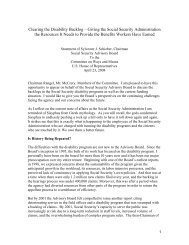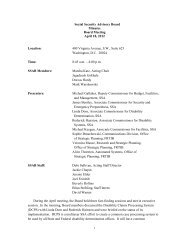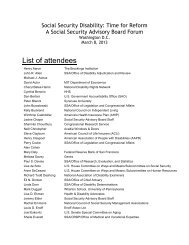Aspects of Disability Decision Making: Data and Materials
Aspects of Disability Decision Making: Data and Materials
Aspects of Disability Decision Making: Data and Materials
Create successful ePaper yourself
Turn your PDF publications into a flip-book with our unique Google optimized e-Paper software.
1967 The Social Security Amendments <strong>of</strong> 1967 (P.L. 90-248) made two important changes to the definition<strong>of</strong> disability in response to a series <strong>of</strong> court decisions that reversed agency denial <strong>of</strong> disabilityclaims involving consideration <strong>of</strong> pain <strong>and</strong> the availability <strong>of</strong> jobs. The new definition made clearthat:■■an individual’s disability must be one “that results from anatomical, physiological or psychologicalabnormalities which are demonstrable by medically acceptable clinical <strong>and</strong> laboratorydiagnostic findings,” <strong>and</strong>■■to be found disabled, an individual must be unable to do any kind <strong>of</strong> substantial gainful workthat exists in the national economy, without regard to whether a specific job vacancy exists orwhether the individual would be hired if he/she applied for work.1968 Following passage <strong>of</strong> the Freedom <strong>of</strong> Information Act in 1966, SSA published the Listing <strong>of</strong> Impairments(“the Listings”) in its regulations (33 FR 11749 (August 20, 1968)). Previously, the Listings,which described medical conditions that that met SSA’s disability st<strong>and</strong>ard, had existed onlyin internal agency operating manuals, <strong>and</strong> were not available to the public.1971 In Richardson v. Perales, 402 U.S. 389 (1971), the U.S. Supreme Court held that a written report <strong>of</strong>a physician who was not the claimant’s own doctor, but who had provided a report on a consultativebasis (i.e., a consultative examination) could constitute substantial evidence to support adecision adverse to the claimant.1972 The Social Security Amendments <strong>of</strong> 1972 (P.L. 92-603) replaced most Federally-aided State programs<strong>of</strong> assistance to the aged, blind <strong>and</strong> disabled with the Supplemental Security Income (SSI)program, which would be administered by the Social Security Administration. <strong>Disability</strong> benefitswere provided not only for adults, but also for children with impairments <strong>of</strong> “comparable severity.”When implemented in 1974, the new law required SSA to perform disability evaluations fora significantly different demographic population, including adults with limited work histories aswell as children. These amendments also reduced the waiting period for disability insurance benefitsfrom six months to five, <strong>and</strong> provided Medicare coverage for disabled SSDI recipients aftertwenty four months <strong>of</strong> benefits.1975 In Cardinale v. Mathews, 399 F.Supp. 1163 (D.D.C.1975), the District Court for the District <strong>of</strong>Columbia held that the government’s procedures for reducing or terminating SSI benefits did notproperly apply the principles <strong>of</strong> the Supreme Court’s Goldberg v. Kelly decision <strong>of</strong> 1970. In Goldbergv. Kelly, 397 U.S. 254 (1970), the Supreme Court held that due process required that publicassistance recipients have an opportunity for an evidentiary hearing before termination <strong>of</strong> theirbenefits. The SSI procedures did not require advance notice or <strong>of</strong>fer a hearing in certain circumstances<strong>and</strong> the District Court found that those procedures violated the constitutional requirementfor due process. SSA published regulations in 1978 (43 FR 18170 (April 28, 1978)) implementinga wide range <strong>of</strong> due process protections for SSI recipients, including advance notice <strong>and</strong>payment continuation rights. (In 1976, the Supreme Court, in Mathews v. Eldridge, 424 U.S. 319(1976), held that Goldberg st<strong>and</strong>ards did not apply to DI benefits.)1977 SSA published the first regulations describing the evaluation <strong>of</strong> disability in children claimingSSI benefits, including additions to the Listing <strong>of</strong> Impairments for children (42 FR 14705(March 16, 1977)).1978 SSA published regulations (effective in 1979) implementing a set <strong>of</strong> medical-vocational guidelines,frequently referred to as the “grid” rules, for assessing certain applicants’ disability statusaccording to their work capacity, age, education, <strong>and</strong> work experience (43 FR 55349 (November28, 1978)). The rules were controversial, <strong>and</strong> resulted in a significant amount <strong>of</strong> litigation.90 <strong>Aspects</strong> <strong>of</strong> <strong>Disability</strong> <strong>Decision</strong> <strong>Making</strong>: <strong>Data</strong> <strong>and</strong> <strong>Materials</strong>









